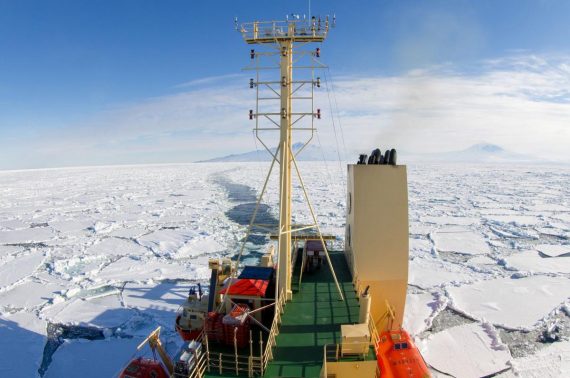A group of scientists, including one from the UA, has new findings suggesting the Antarctica’s Southern Ocean — long known to play an integral role in climate change — may not be absorbing as much pollution as previously thought. The old belief was the Southern Ocean pulled about 13 percent of the world’s carbon dioxide… View Article
Uncertainties around carbon emissions will make climate agreements tough to enforce. The answer floats in the seas, says Joellen Russell. Almost 200 nations have pledged to reduce their greenhouse-gas emissions under the Paris Agreement on climate change. We need a way to know whether they are succeeding. For the accord to work, each country must… View Article
UA Seeks Answers From the Deep
02/28/2018
From the Southern Ocean, professor Joellen Russell is collecting big data that is expected to tell us more about the Earth and its climate. Clad in an orange life jacket and hard hat, Becki Beadling hustles to the stern of the research ship. She hears the hum of the engine and the sound of the… View Article
Joellen Russell has a vision of holding countries accountable for their carbon-dioxide emissions. She and her research team are focusing their work in Antarctica’s Southern Ocean — which absorbs a significant portion of the man-made heat generated in the world — to measure the amount of carbon in the water. Carbon dioxide is a byproduct… View Article
Researchers are studying the ocean’s carbon dynamics to improve predictions for sea level and temperature rise. By Jeff Tollefson, Nature magazine on November 16, 2016 Joellen Russell wasn’t prepared for the 10-metre waves that pounded her research vessel during an expedition south of New Zealand. “It felt like the ship would be crushed each time we rolled into a… View Article
NSF, NOAA and NASA are funding the UA and others to study the Earth’s climate with robotic floats and supercomputers. Shelley Littin, Cyverse As global climate change accelerates with increasingly substantial impacts on communities worldwide, the need to understand and make reliable projections of future climate becomes ever more imperative. The National Science Foundation-funded Southern… View Article
Initiatives aim to measure global warming’s impact on high seas and deep currents By Jeff Tollefson, Nature magazine on March 22, 2016 The Southern Ocean guards its secrets well. Strong winds and punishing waves have kept all except the hardiest sailors at bay. But a new generation of robotic explorers is helping scientists to document the region’s influence on… View Article
This year’s College of Science Lecture Series, “Earth Transformed,” will showcase UA researchers’ expertise on climate change and its implications for the planet. Amy Williams and Alexis Blue, University Relations – Communications Jan. 20, 2016 The University of Arizona, an international leader in global climate change research, will share its scientists’ expertise with the community… View Article
China’s Loess Plateau was formed by wind alternately depositing dust or removing dust over the last 2.6 million years, according to a new report from University of Arizona geoscientists. The study is the first to explain how the steep-fronted plateau formed. Wind blew dust from what is now the Mu Us Desert into the huge… View Article
By Samantha Mathewson New research explains the formation of China’s steep-fronted Loess Plateau, an area of consolidated dust and erosion that covers more than 640,000 kilometers in the country’s northwest. Geoscientists from the University of Arizona (UA) explained that over the past 2.6 million years, wind has either been depositing dust blown from the Mu Us… View Article
spacer
spacer
Previous 1 2 3 Next
